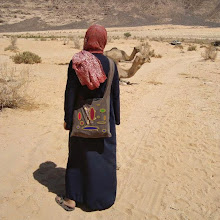Note: Some of the sequences of events and identities of
individuals involved have been changed to protect privacy of my friends and
contacts.
After faced with the apparent security issue that my
frenetic dress code was causing, I decided to bite the bullet and fully commit
to nikaab for a month – as a means of
deciding as to whether I could wear it forever at the end of that month. I spoke to my neighbor, who supported the
idea, and was off. A commitment to covering
my face in all spaces outside of my home was a tall order given that for every
place I frequent where nikaab is
embraced there is another where it is rejected.
No longer did I feel comfortable accompanying friends to Aqaba’s
international restaurants and hotels – even the public consumption of food was
now a challenge.
Fortunately, I am surrounded by a community of friends and
neighbors, who regardless of their opinion, acted in great support of the
choice I had made – either by speaking supportively, offering intellectual
challenges to my thinking or by simply explaining to others my intention and
actions. (It’s a strange thing for an
unmarried foreign woman working in tourism to choose to cover her face – lots of
explaining resulted.)
Each day brings a new lesson as I continue to explore intention,
action and interaction.
I’ve been doing reservations work for a well-established,
highly professional, locally run camp in Wadi Rum. On a weekly basis, I travel to my place of
work to share the upcoming week’s reservations with the camp’s owner, to plan
the coming week’s work and to check out any changes to the camp – a space that
is in a constant state of dynamic change – as we add solar power, renovate the
bathrooms and make small yet important improvements to the service that we
provide to our guests. Our staff (excluding
myself) is 100% male and Arab and our guests are probably around 90% non-Arab,
non-Muslim.
“Your English is
excellent!,” one German man tells me.
“I’m Italian
American. I was born in the United States.”
I explain.
Women, in particular,
are curious to understand my dress choice.
Every one with whom I speak is accepting of a choice made to better
integrate culturally.
One morning, an
Italian guest asks to take my photo.
It’s clear he is under the impression that I’m a local woman. I feel confused as to how to respond – as a
general rule, local women are never photographed, thus ensuring protection of honor
and identity. I’m not local but I’m
covered. I share this quandary with one
of my co-workers. It’s your choice, he
responds.
The following week,
staff and guests sit around the fire, enjoying tea and music. ‘Lina,’ says one of my colleagues, ‘tell the
guests that you are a foreigner.’ A good save.
--
For years, I’ve been friends with a foreign woman in the
area who owns an upscale desert accommodation and caters both to foreign guests
and to local weekenders. The atmosphere
is reminiscent of Aqaba’s international hotels and dress code runs the gamut of
possibilities from the traditional to the modern; tank-top to hijab; middle-class to wealthy. Another friend has recently started a farming
project there and the reservations manager is also from outside of Jordan. We’ve dubbed ourselves the asheera al ajnebiyat (the tribe of the
foreign ladies), and have been known to travel through the desert as a pack intimidating
camels and scavenging cardboard boxes to use as mulch for the farm project.
I visit one evening
for dinner. We sit in a comfortable
corner of the dining area. For two of my
friends, it’s cocktail hour. Our group
draws curious glances from the guests.
Friends arrive from
Aqaba with visitors from abroad in tow.
‘Alena,’ says one of
them. ‘I absolutely cannot talk to you with that on your face.’
‘Why not?’ I challenge
her.
‘I just can’t. It’s fine when you are in my house and I can
see your face. But it doesn’t seem fair
that I can’t see your face but you can see mine while we are talking!’
We decide to sit back
to back while we converse.
I reflect that I have always used the faces of other humans
as a door through which to identify and to connect with them. The few friends of mine who permanently wear nikaab either stand out in their dress
choice or are women with whom I engage predominantly in private settings. Wearing nikaab
publicly has challenged my basic assumptions about how I interact with and am
identified by other humans.

